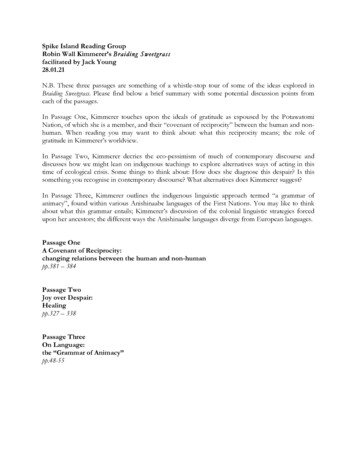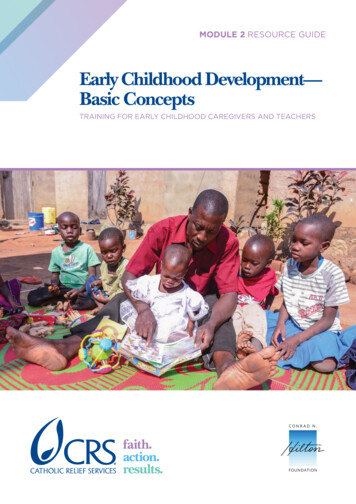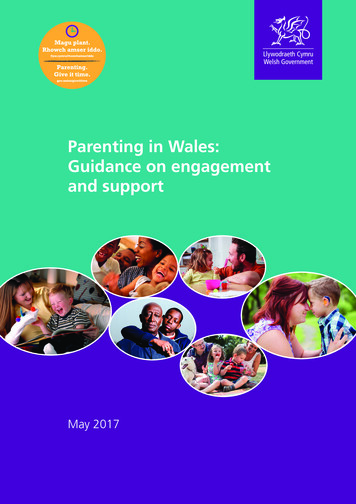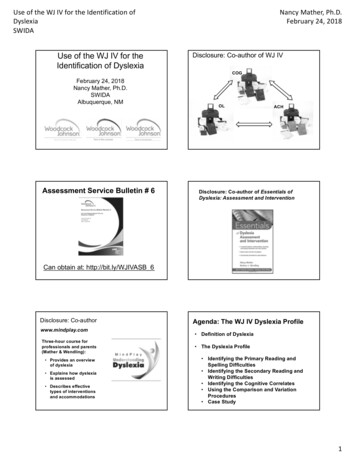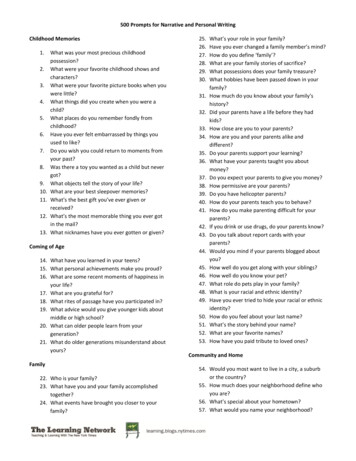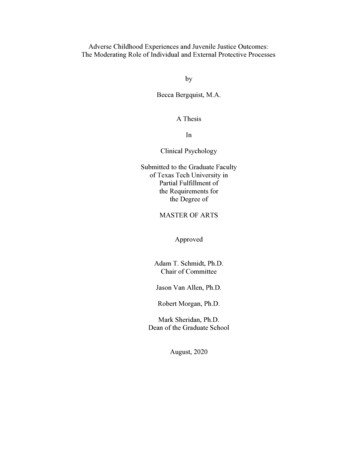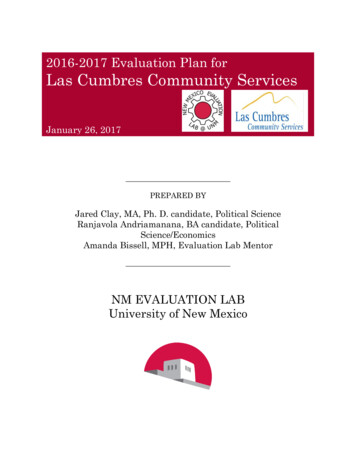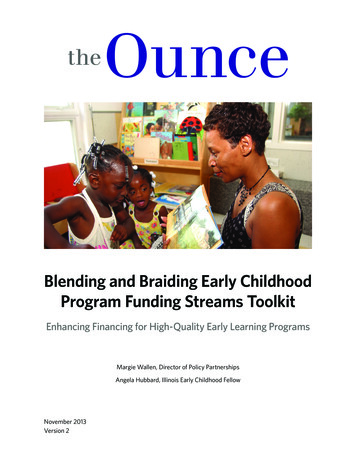
Transcription
Blending and Braiding Early ChildhoodProgram Funding Streams ToolkitEnhancing Financing for High-Quality Early Learning ProgramsMargie Wallen, Director of Policy PartnershipsAngela Hubbard, Illinois Early Childhood FellowNovember 2013Version 2
Version 2Publication date: November 2013Authors: Margie Wallen and Angela HubbardSpecial thanks to the many state leaders whocontributed to the state pages of this toolkit, JasonSommer for his hard work on layout and design,Ashanti Huey and Liliana Velázquez for their helpwith finalization and the Ounce of Prevention’snational policy team.We are also grateful for the support of the BuffettEarly Childhood Fund, which provided funding forthis project.Feedback: We welcome feedback on this tool andmay incorporate suggestions in subsequent versions.Please send comments and questions to MargieWallen at mwallen@ounceofprevention.org.For more information about the Ounce of PreventionFund’s national policy work, please visit www.ounceofprevention.org/nationalpolicy.
Table of ContentsAbout the Ounce of Prevention Fund and National Policy Team. pg. 3Part I: Introduction.pg. 5A. Toolkit Overview.pg. 6B. Defining Blending and Braiding.pg. 7Part II: Using Current Early Care and Education Funding Streams to Support High-QualityServices.pg. 8A. Features of High-Quality Early Care and Education Programs.pg. 8B. Current Public Early Care and Education Funding Streams for Young Children.pg. 9C. Why Blending and Braiding is Needed.pg. 14D. The Evolution of Blending and Braiding Approaches.pg. 15Part III: How Blending and Braiding Should Work: Common Challenges and PolicyRecommendations. pg. 16A. Aligning Regulations Across Early Childhood Funding Streams.pg. 16i. Eligibility and Enrollment Issues.pg. 16ii. Programmatic Issues.pg. 18iii. Funding Issues.pg. 20Part IV: Promising State Blending and Braiding Practices.pg. 22A. Illinois Child Care Collaboration.pg. 23B. Pennsylvania Cost Allocation.pg. 24C. Oregon Program of Quality Contracted Child Care.pg. 25D. Washington 12-Month Eligibility and Income Reporting.pg. 26Part V: Resources.pg. 28A. National Reports.pg. 28B. Useful Websites.pg. 29C. State Reports.pg. 29Part VI: State Data and Worksheets.pg. 30A. Data by State and Comparisons Across States.pg. 32B. State Data Pages.pg. 36C. Assessing Federal, State and Local Public Funding Streams.pg. 60D. Identifying Regulatory Differences Across Early Childhood Funding Streams.pg. 62
About the Ounce of Prevention FundFounded in 1982, the Ounce of Prevention Fund’s mission is to give children in poverty the best chance for successin school and in life by advocating for and providing the highest quality care and education from birth to age five. Asa comprehensive early childhood organization, the Ounce engages in practice, research, professional developmentand policy advocacy.All of the Ounce’s advocacy work is focused on improving outcomes for at-risk infants, toddlers and preschoolers.We advocate for increased public investment and public policies that: Direct resources to the youngest and most at-risk children from birth to age five Implement high-quality and evidence-based practices Provide access to high-quality practice in a range of settings and models Address at-risk children’s comprehensive needs Invest in infrastructure to support programs and build a cross-sector system that achieves coherence inareas such as standards, curriculum, assessment, professional preparation and development, and familyengagement across funding streams.The Ounce’s national policy team partners with and supports early childhood leaders in states as they advancea comprehensive agenda for at-risk children and families. We do this by providing individualized strategy andpolicy consultation and resources; facilitating peer-to-peer learning and networking across states; and supportingEducare Schools and the Educare Learning Network in the development of their policy and advocacy work. Formore information about the national policy team, visit www.ounceofprevention.org/nationalpolicy.3
4Blending and Braiding Early Childhood Funding Streams Toolkit
PART I: INTRODUCTIONIt’s common knowledge that children need high-quality early learning experiences to improve their long-term educationaloutcomes and that families need child care arrangements that meet their need to work, which can be particularly challengingfor low-income families working full time and often in multiple jobs. Evidence continues to mount regarding the influencechildren’s earliest experiences have on their later success and the role early care and education programs can play inshaping those experiences as well as contributing to parents’ job stability and families’ financial health. However, lowincome children experience large school readiness gains only when they have consistent access to responsive teachers andcaregivers in high-quality early learning environments.Because no single federal or state funding source adequately addresses both of these needs, individual early care andeducation programs have sought to foster healthy child development and promote families’ economic self-sufficiency bycombining existing funding streams through “blending” and “braiding” funds. In fact, in order for programs to effectivelydeliver high-quality, comprehensive, full-workday, full-year early education programming to vulnerable young childrenand families, they must maximize public and private sector investments by using funds from two or more funding streams,such as Early Head, Head Start, the Child Care and Development Fund (CCDF—also called Child Care assistance or ChildCare subsidy), state pre-kindergarten (pre-k), and state infant-toddler (0–3) programs.BLENDING AND BRAIDING AT THE PROGRAM LEVELAt the program level, when funds are blended, funds from two or more separate funding sources are wrapped togetherwithin one full-workday, full-year program budget to pay for a unified set of program services to a group of children. Inblending, costs are not necessarily allocated and tracked by individual funding source. When funds are braided, two or morefunding sources are coordinated to support the total cost of services to individual children, but revenues are allocated andexpenditures tracked by categorical funding source. In braiding, cost allocation methods are required to assure that there is noduplicate funding of service costs and that each funding source is charged its fair share of program and administrative costs.At the individual program level, these financing strategies are inefficient and costly because significant staff time andresources are necessary to manage the different, and often conflicting, program eligibility requirements, quality standards,and funding mechanisms required by each funding stream. These resources would be better spent on enhancing programquality and service continuity. Regardless of how budgets are developed, if a child in a full-workday program that dependson Head Start and child care funding loses her child care subsidy midway through the year because the funding sourceshave differing eligibility requirements, the child either cannot complete the program or the service provider cannot coverits expenses. At the child and family level, the loss of one funding source destabilizes a low-income child’s ability to benefitfrom quality early learning experiences, as well as her parents’ ability to work. These challenges also create disincentivesfor many providers to serve the highest need children who depend on public funding to access the early learning experiencesthey need before kindergarten entry.RECOMMENDATIONSIt is more efficient for entities that administer early childhood program funds to develop and harmonize policies, rules,regulations and procedures on blending and braiding at the “upstream” or government agency administrative level, ratherthan at the individual family and provider or “downstream” level. At the policy level, blending and braiding are financingstrategies that federal, state and local policymakers and program administrators can use to integrate and/or align discretecategorical funding streams to broaden the impact and reach of services provided with Early Head Start, Head Start, statepre-k, state 0–3, and child care dollars. Public funders must work together to make it easier for many more early learningservice providers to use multiple funding streams in order to attain the scale needed to efficiently deliver high-qualityservices that result in meaningful outcomes for young children at greatest risk for poor developmental and school outcomesand their families. For the foreseeable future, blending and braiding funds is a necessary financing approach to supporthigh quality, continuous early learning and development services for children from birth to age five. Advocacy to increasepublic and private sector resources and for new financing mechanisms (e.g., tax credits) are critical, but these too must workin harmony with existing funding streams toward the goal of shared, coherent financing for high-quality early care andeducation.5
A. Toolkit OverviewThis toolkit is designed to provide state advocates and policymakers with strategies, tools, resources and optionsto make policy choices that facilitate the blending and braiding of funding streams to improve access to and lengthof children’s participation in full-workday, full-year, high-quality early learning programs that benefit vulnerableyoung children and working families.Through the toolkit, the Ounce seeks to:1. Expand the ways state early childhood leaders think about the benefits and challenges of using public early care andeducation funds from two or more program funding streams—Early Head Start, Head Start, state pre-kindergarten(pre-k), state infant-toddler, and the Child Care and Development Fund (CCDF—but often called child care assistanceor child care subsidy)—to pay for the expenses of full-workday, full-year, high-quality early learning programs servingchildren at greatest risk for school failure;2. Highlight promising policies and practices that promote consistent participation in high-quality early learning programsthat effectively prepare children for success in school;3. Offer state-specific and cross-state information on selected policies that encourage blending and braiding of EarlyHead Start, Head Start, state pre-k, and child care funds to sustain program quality and service continuity, as well asadditional resources on state early learning financing policies; and4. Offer worksheets to compare requirements across federal and state early childhood funding streams in order to identifyspecific policy barriers to blending and braiding funding streams in a state.The Blending and Braiding Toolkit is organized into six sections.Part I: Introduction This section gives an overview of the toolkit and defines the terms, blending and braiding.Part II: Using Current Early Care and Education Funding Streams to Support High-Quality Services Thissection covers four topics: 1) the features of high-quality early care and education programs that hold the most promisefor closing the achievement gap for low-income children; 2) the differing requirements of the major program fundingstreams (Early Head Start, Head Start, child care, state pre-k, and state infant-toddler funding) that make it difficult tofinance comprehensive, full-workday, full-year early learning programs; 3) rationales for policies that promote blendingand braiding; and 4) how the most prevalent approaches to blending and braiding work and have evolved over time.Part III: How Blending and Braiding Should Work: Common Challenges & Policy Recommendations Thissection describes the most common regulatory differences in eligibility criteria and enrollment processes, programmaticrequirements, and funding levels and payment mechanisms among the major early learning funding streams, and offerspolicy recommendations to better align them.Part IV: Promising State Blending and Braiding Practices This section highlights four state examples that demonstratecreative and varied purposes for and approaches to blending and braiding early childhood program funding streams.Part V: Resources This section offers weblinks to national and state reports and websites that are useful to developpolicy proposals to improve public financing for high-quality early care and education programs serving low-incomeyoung children and families.Part VI: State Data and Worksheets This section contains data tables organized by state and policy strategy. Thesetables are meant to identify opportunities for advocacy within existing state policies, as well as ideas for using multiplefunding streams that are not yet in place in your state or locality. The state data tables also provide information aboutnational policy trends and momentum. You will also find two tools to facilitate a detailed analysis of the current fundinglandscape within a state: Assessing Federal, State, and Local Funding Streams and Identifying Regulatory DifferencesAcross Early Childhood Programs.6Blending and Braiding Early Childhood Funding Streams Toolkit
B. Defining Blending and BraidingThere are no commonly used definitions for the terms “blending” and “braiding” funding streams so it is important tobegin by defining terms. In this toolkit, we have adopted the following definitions for blending and braiding put forth inan October 2008 Early Care and Education Policy Brief entitled Increasing Access to Preschool: Recommendations forReducing Barriers to Providing Full-day, Full-year Programs published by Children Now and the California Child CareResource & Referral Network.1BLENDING Funds from two or more separate funding sources are wrapped together within one full-workday,full-year program budget to pay for a unified set of program services to a group of children. In blending,costs do not have to be allocated and tracked by individual funding source.BRAIDING Funds from two or more funding sources are coordinated to support the total cost of services toindividual children, but revenues are allocated and expenditures tracked by categorical funding source. Inbraiding, cost allocation methods are required to assure that there is no duplicate funding of service costsand that each funding source is charged its fair share of program and administrative costs.OTHER TERMS FOR “BLENDING” OR “BRAIDING”Cost allocation (Pennsylvania)Layering (Kansas)Collaborative funding (Illinois)Cost sharingCoordinated resource sharingBecause each government agency administering a categorical funding stream typically requires that its funds be trackedseparately, braiding strategies at the individual program level are more widespread. This requires skilled staff, a high degreeof record keeping, a good management information system, and a strong cost accounting system to track expenditures byfunding source, often at the child level, in order to properly allocate and report them. Many providers of early care andeducation are small centers or family-based homes that do not have the administrative capacity to manage the requirementsof multiple funding sources. Blending approaches are most frequently used when government entities pool or encourageblending funds from several different program sources to allow local programs increased discretion in the use of thecombined funds to support more comprehensive, continuous services.7
PART II: USING CURRENT EARLY CARE AND EDUCATIONFUNDING STREAMS TO SUPPORT HIGH-QUALITY SERVICESThis section covers four topics: 1) the features of high-quality early care and education programs that hold the most promisefor closing the achievement gap for low-income children; 2) the differing requirements of the major program fundingstreams (Early Head Start, Head Start, child care, state pre-k and state infant-toddler funding) that make it difficult tofinance comprehensive, full-workday, full-year early learning programs; 3) rationales for policies that promote blending andbraiding and 4) how the most prevalent approaches to blending and braiding work have evolved over time.The greatest returns on early learning investments result when funds are efficiently coordinated across levels of governmentand different types of programs to support highly effective early care and education programs.2 However, presently each ofthe largest public funding streams set their own accounting and reporting requirements and criteria for who is eligible, whatchildren need to know and do (early earning standards), and how teachers and caregivers and the programs that employthem effectively support early learning (practitioner standards and program performance standards). In order to cover thecosts of high quality, blending and braiding is the only alternative for many service providers serving low-income childrenin working families.A. Features of High-Quality Early Care and Education ProgramsWe know that experiences children have early in life shape whether their foundation for good health and later learningis sturdy or fragile. Because young children’s learning occurs in the context of reciprocal relationships with adults andcaregivers, it is difficult to tease apart children’s cognitive, social, and emotional development during these years. Theyare inextricably intertwined.3 The National Association for the Education of Young Children (NAEYC) describes a highquality early learning program as providing “a safe, nurturing environment that promotes the physical, social, emotional andcognitive development of young children while responding to the needs of families.” Early learning program effectivenessdepends on the quality of interactions between the child and the teacher or caregiver that occurs through ambitiousinstruction, which requires child-centered supportive learning environments, embedded professional development thatbuilds teachers’ capacities, strong parent-community-program ties and partnerships, and inclusive leadership that drivescontinuous learning and improvement.Effective approaches that foster vulnerable young children’s healthy development ensure that their early learning experiencesare of high quality and adequate dosage. This requires that children’s early childhood settings provide intentional anddevelopmentally appropriate instruction that balances physical, cognitive, social and emotional development (quality). Italso requires that a child’s learning opportunities provide an adequate amount of time through the course of a year, aswell as year after year, for children to have child-friendly yet instructionally rich experiences (dosage). We currently lackdefinitive data on the minimum quantity and mix of inputs required for highly effective programs. However, programs thathave produced large gains for children share similar characteristics:LOW TEACHER/CAREGIVER-CHILD RATIOS AND SMALL GROUP SIZESFewer children per adult allows educators to tailor instruction to children’s styles and pace of learning.SAFE PHYSICAL ENVIRONMENTChildren’s natural curiosity is stimulated by an environment within which they can explore safely and semi-independently.AGE-APPROPRIATE MATERIALSChildren are able to access resources. Materials encourage exploration and extension of prior knowledge.8Blending and Braiding Early Childhood Funding Streams Toolkit
WELL-QUALIFIED TEACHERS/CAREGIVERS AND ONGOING STAFF DEVELOPMENTTeachers and caregivers possess college degrees and specialized training in early education and child development asindicated by certifications and endorsements. Staff attainment of advanced education and training is encouraged. Datadriven instructional practices and individual professional development plans are implemented.WARM, RESPONSIVE TEACHER/CAREGIVER-CHILD INTERACTIONSEducators are mindful of and sensitive to children’s social emotional development and family context.INCLUSIVE PROGRAM LEADERS WHO ESTABLISH CONDITIONS THAT SUPPORT EFFECTIVE PRACTICEReflective practice and supervision occur routinely. There is protected time for staff collaboration and planning.LANGUAGE-RICH ENVIRONMENTEducators provide profuse exposure to vocabulary that extends children’s learning, and multiple formats of accessibleprinted materials are used.INTENTIONAL INSTRUCTIONEducators individualize instruction based on early learning and development standards, as well as children’s interests,dispositions, and prior achievements. Educators are intentional about allowing for open-ended responses to encouragehigher order thinking; creativity is encouraged.SOCIAL EMOTIONAL SUPPORTSocial-emotional developmental theory intentionally informs all aspects of the program. All staff is trained to useproactive, positive approaches to discipline, and the environment and staff behavior emphasize the centrality ofrelationships.STRONG FAMILY AND COMMUNITY ENGAGEMENT AND SUPPORTDedicated staff with specialized training connect families to community resources and engage in active two-waycommunication to support the success of both the child and the family.CONTINUITY OF CARETo minimize transitions and help children develop secure relationships, programs are mindful of and seek to minimizedisruptions, including changes in settings, staff group assignments, staff turnover and natural transitions such asentering and exiting programs. Staff uses proactive practices to reduce absenteeism.B. Current Public Early Care and Education Funding Streams for Young ChildrenNo one funding stream covers the full cost of the features that are present in highly effective full-workday, full-yearprograms, requiring higher-quality early learning programs to secure two or more funding streams. But differences infamily eligibility criteria and enrollment processes, programmatic and workforce requirements, and funding levels andpayment mechanisms between the major program early childhood funding streams—Early Head Start, Head Start, childcare, state pre-k, and state infant-toddler (0–3) funding—make it hard to finance comprehensive, full-workday, full-yearearly learning programs. For example, state pre-k is typically the only funding source that covers the cost of a certifiedteacher with specialized training in early education. Early Head Start and Head Start are the only funding sources that payfor dedicated family support personnel and health, mental health, nutrition, and social services. Typically, pre-k and HeadStart funds only pay for half-day or school-day programming, requiring parents to secure child care subsidies or privatelypay for the early morning and late afternoon hours that cover a full workday. In addition, in most states reimbursement ratesfor child care, pre-k, and state-funded 0–3 programs have not been increased over the years making it increasingly difficultfor providers to cover rising costs from year to year.Table 1 on the following pages4 offers a comparison of key features of federal, state, and local early learning programfunding streams.9
Table 1: Largest Early Learning Program (Funding Stream) RequirementsEarly Head Start/Head StartChild Care Subsidies(includes CCDF & TANF)AdministrativeAgencyUS Department of Health and Human ServicesUS Department of Health and Human ServicesSource of Funds &Payment ProcessFederal grants distributed to public and privatesector local grantees that must follow detailedfederally mandated program and performancestandards.Federal Child Care and Development Fund(CCDF) and Temporary Assistance to NeedyFamilies (TANF) funds. Both CCDF andTANF require states to provide matchingfunds and to meet maintenance of effortrequirements. Providers are reimbursedbased on state or local rates. Most funds aredistributed through vouchers, and familiesare required to contribute to the cost of carethrough co-payments to their provider.Parent Co-PayNoneVaries by state. Typically based on familysize, income, a sliding fee scale, and child careschedule (full or part time).Primary ServiceComprehensive program to enhance thephysical, cognitive, social and emotionalgrowth of infants, toddlers, and preschoolers;to support parents’ (including pregnantwomen) efforts to fulfill their parentalroles; and to help parents move toward selfsufficiency.Child care assistance for children up to age13 from low-income families working and/or participating in an approved educationor training program. Federal policy allowsstates broad discretion in defining regulations.States must establish basic health and safetyrequirements for all providers, but arepermitted to exempt certain providers. Qualityregulation is left up to the states, many ofwhich have weak standards. Most states havelaunched quality rating and improvementsystems to elevate the quality of care topromote children’s healthy development.Length of Day/YearEarly Head Start: full-year; centers full-day.Home-based: minimum 32 home visits of atleast 1.5 hours each & 16 grp. socializationactivities/year. Head Start: minimum 3.5 &maximum 6 hrs/day; 128 days/year. Minimum4 days/week & 160 days/year minimum 5days/week.Varies by state, as do definitions of full-dayand part-day rates.Features10 Blending and Braiding Early Childhood Funding Streams Toolkit
Table 1: Largest Early Learning Program (Funding Stream) Requirements [cont.]Early Head Start/Head StartChild Care Subsidies(includes CCDF & TANF)Child & FamilyEligibilityAvailable to pregnant women & familieswith incomes up to 100% FPL or 130% ifall in 100% level are served. Children ages3–5 (Head Start) or 0–3 (Early Head Start).Homeless children and children in childwelfare are categorically eligible. Childrenwith disabilities must comprise at least 10% ofchildren served. Up to 10% of children can beover income.Available to working families with incomesup to 85% SMI (CCDF) or who are needy asdefined by the state (TANF), children ages0–13. State rules vary.Child Age RangeHead Start: age 3 to mandatory school age.Early Head Start: birth to age 3 and pregnantwomen.Birth to age 13; to age 21, if developmentallydisabled or otherwise in need of care.Length ofEligibilityEarly Head Start: children remain eligibleuntil they are eligible to enter Head Start.Head Start: children remain eligible for twoenrollment years.Varies by state.ImpactA 2010 national study of Head Startdemonstrated that, overall, the longerchildren were enrolled in Head Start beforeentering kindergarten, the greater the ratesof kindergarten readiness and sustainedcognitive, social-emotional, and healthoutcomes than their peers.Studies have raised concerns that subsidizedcare can be of such low quality that it haslittle or no positive effects on learning anddevelopment of children prior to kindergarten,and might even have modest negative effects.Features11
Table 1: Largest Early Learning Program (Funding Stream) Requirements [cont.]FeaturesState Pre-kindergartenState Infant-Toddler (0–3)Local ProgramsAdministrativeAgencyState departments of educationfor 29 states and 11 states withother agencies (may be jointlyadministered)Statedepartmentsofeducation or state agenciesSchool districts and/or otherstate and local agenciesSource of Funds &Payment ProcessState funds, typically withlocal and sometimes federalfunds (e.g., Title I). Paymentprocess varies by state (e.g.,school aid funding formulaallocations to school districts;grants to eligible entities,including community-basedorganizations).State funds with local andsometimes private funds.Payment process varies bystate.Determined at the state orlocal level. Payment processvaries by locality.Parent Co-PayVaries by state. Typicallynone.Varies by state. Typicallynone.Varies by locality.Primary ServiceEducatio
4. Offer worksheets to compare requirements across federal and state early childhood funding streams in order to identify specific policy barriers to blending and braiding funding streams in a state. The Blen



